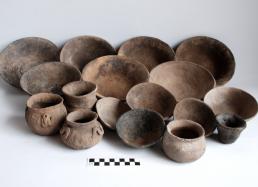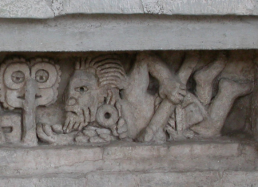2009: Tombs & Thighbones
During their 2009 season at the Mitla Fortress, Dr. Feinman’s team excavated a commoner's house on Terrace 56, discovering beneath its floors and within its still-visible walls 16 different burials containing the bones of 21 individuals. Indeed, the findings at the Fortress seem to align with Mitla’s historic association as “the place of the dead.”
The custom of burying people under the floors of houses may seem strange to us today, but the practice is not so different from that of many Christian cathedrals that contain the bones of priests, kings, and elite members of society beneath their marble floors. Today in Mexico, the Day of the Dead festival blends both Christian and ancient Mesoamerican customs, honoring the deceased not only through prayers, but also meals and other favorite memories shared with departed family members at their gravesites and at home.
The Role of the Dead
The Zapotec saw death quite differently than many modern Americans do. Death was not the end, but merely a transition into a new phase of the relationship with a loved one. Burying deceased relatives close at hand not only invested homes with familial history, but also kept the beloved part of family happenings. Plus, ancestors were viewed as a conduit to the supernatural world, and the Zapotec established a spiritual bond by regularly making offerings to their dead at household altars or at the graves themselves.
But beyond their affirmation of the departed’s role in the family and spiritual world, the burials at Mitla Fortress offered an additional important piece of information—they support the idea that the de-fleshed femurs from important individuals buried within the home served as symbols of legitimacy and status. Some Zapotec (as well as other prehispanic Mesoamerican) leaders brandished these reclaimed bones to assert their inheritance of authority from their forebears.
Femurs as Scepters
Within an adobe-lined burial cist beneath the house of a commoner, Dr. Feinman found the remains of an adult male, virtually intact except for his missing right femur (thighbone). The bone appears to have been intentionally removed sometime between 25 - 100 years after the man’s death, with the grave having been carefully resealed and honored with an offering thereafter. Since the house was continuously occupied, the intrusion was likely performed by a family member, possibly a son or grandson looking to proclaim his birthright—perhaps a neighborhood office once held by an esteemed ancestor.
This finding helps explain images carved in tomb facades that show Zapotec leaders brandishing femurs. Apparently, carrying the thighbone of an ancestor during important rituals legitimized the leader’s position of authority, illustrating that his power had passed down through generations in an unbroken line of descent from the founding father. And clearly, since this particular home belonged to a commoner, the custom may not have been restricted just to elites.
To learn more about this discovery, please check out the Expedition Burial Practices Photo Gallery, or download the National Geographic News article “Ceremonial Femurs” or the Wired Science article “Lost Civilizations Seen in Zapotec Thighbones.” And be sure to check out the 2010 season’s summary "Ritual Spaces" to learn about more discoveries that shed light on the story of the thighbone.



